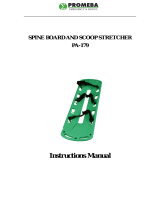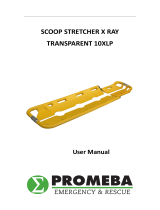
HMManual, Rev. K www.HoverMatt.com | 7
User Manual
Cleaning and Preventive Maintenance
In between patient uses, the HoverMatt should be wiped down with a
cleaning solution used by your hospital for medical equipment disinfec-
tion. A 10:1 bleach solution (10 parts water: one part bleach) or disinfec-
tant wipes can also be used. It is important to follow the cleaning solution
manufacturer’s instructions for use, including dwell time and saturation.
NOTE: Cleaning with bleach solution may discolor fabric.
If a reusable HoverMatt becomes badly soiled, it should be laundered in
a washing machine with a 160° F (71° C) maximum water temperature. A
10:1 bleach solution may be used (10 parts water: one part bleach) during
the wash cycle.
The HoverMatt should be air dried if possible. Air drying can be expedited
by using the air supply to circulate air through the inside of the HoverMatt.
If using a dryer, the temperature setting should be set on the coolest setting.
Drying temperature should never exceed 115° F (46° C). The backing of
the nylon is polyurethane and will begin to deteriorate after repeated high
temperature drying. The Double-Coated HoverMatt should not be put
in the dryer.
To help keep the HoverMatt clean, HoverTech International recommends
the use of the HoverCover™ Disposable Absorbent Cover or their
Disposable Sheets. Whatever the patient is lying on to keep the hospital
bed clean may also be placed on top of the HoverMatt.
The Single-Patient Use HoverMatt is not intended to be laundered.
AIR SUPPLY CLEANING AND MAINTENANCE
See air supply manual for reference.
NOTE: CHECK YOUR LOCAL/STATE/FEDERAL/INTERNATIONAL GUIDELINES
BEFORE DISPOSAL.
PREVENTIVE MAINTENANCE
Prior to use, a visual inspection should be performed on the HoverMatt to
ensure that there is no visible damage that would render the HoverMatt
unusable. The HoverMatt should have all of its patient safety straps and
handles (reference the manual for all appropriate parts). There should be
no tears or holes that would prevent the HoverMatt from inflating. If any
damage is found that would cause the system not to function as intended,
the HoverMatt should be removed from use and returned to HoverTech
International for repair (Single-Patient Use HoverMatts should be discarded).
INFECTION CONTROL
HoverTech International oers superior infection control with our heat-
sealed reusable HoverMatt. This unique construction eliminates the needle
holes of a sewn mattress which can be potential bacterial entry ways.
Additionally, the heat-sealed, Double-Coated HoverMatt oers a stain and
fluid proof surface for easy cleaning. The Single-Patient Use HoverMatt is
also available to eliminate the possibility of cross-contamination and the
need for laundering.
If the HoverMatt is used for an isolation patient, the hospital should employ
the same protocols/procedures it utilizes for the bed mattress and/or for
linens in that patient room.
OPTION 1
Place the HoverMatt on the Pre-Op stretcher or bed prior to patient arrival.
Have patient ambulate onto bed/stretcher or use a HoverMatt to perform a
lateral transfer. Once in the OR, ensure the OR table is secured and locked
to the floor, then transfer the patient onto the OR table. Have a caregiver
at headend of OR table ensure the patient is centered before deflating the
HoverMatt. Position the patient as needed for surgery. Tuck the edges of the
HoverMatt under the OR table pad, and ensure table rails are accessible. For
supine surgeries, follow your facility’s patient positioning protocol. After the
case, release the edges of the HoverMatt from under the OR table. Buckle
patient safety straps loosely. Partially inflate the HoverMatt using the ADJUST-
ABLE setting, have headend caregiver ensure the patient is centered, then
fully inflate using the appropriate high speed setting. Transfer the patient to
the stretcher or bed.
OPTION 2
Prior to patient arrival, place the HoverMatt on the OR table and tuck the
edges under the OR table pad. Ensure table rails are accessible. Transfer
the patient onto the table, and proceed as described in Option 1.
TRENDELENBURG POSITION
If Trendelenburg or Reverse Trendelenburg is required, an appropriate
anti-slide device that secures to the frame of the OR table must be used.
For Reverse Trendelenburg, a device that clamps to the OR table frame,
such as a footplate, should be used. If the surgery also includes a tilt side-
to-side (airplaning), the patient must be safely secured to accommodate
this position prior to starting surgery.
Using the HoverMatt® Air Transfer System in the Operating Room















